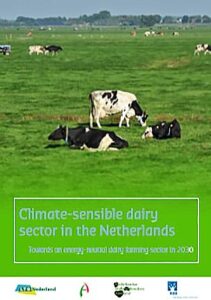Share this page
Action plan for a climate resilient dairy sector
Mobilizing the Dutch dairy sector to become climate resilient by translating a collective national long-term goal into short term individual actions and responsibilities.


Alignment with SDGs
AUTHOR
Bregje van Erve (ZuivelNL); Tjitske Bolt (NZO - Dutch Dairy Association) ZuivelNL - Sustainable Dairy Chain Program (Duurzame Zuivelketen - DZK) • The Netherlands
Abstract
Following the Paris Agreement, the Dutch Government approved a Climate Act in which the Netherlands’ climate goals are set. In the National Climate Agreement, a nationwide agreement between governments, NGO’s and private sector parties, the dairy sector played an active role by submitting a detailed and tailormade action plan. The dairy sector committed to reduce the emission of greenhouse gasses significantly towards 2030. The goal of the dairy sector is to take necessary steps across the total production chain to be as effective as possible to reduce the emission and to avoid unwanted transfer of issues to other important topics.
Becoming more climate resilient is a license to operate for any economic sector and especially for the Dutch dairy sector.
The aim of the dairy action plan is to reduce the emission of greenhouse gasses in the dairy chain by initiating collective actions of dairy processors and farmers’ organizations and to accomplish a joint and structural dedication to this important goal. Long-term commitment and responsibility at individual farm level are main drivers as well as supporting the farmers and other stakeholders in the dairy chain (feed industry, genetics etc.) by taking mitigating actions.
Moving the wheel
The dairy action plan describes clearly how the dairy sector can develop towards an energy-neutral farming sector in 2030. The action plan, amongst others, provides and describes the measures for reduction that can be taken in the areas of: 1. Animal and feed; 2. Manure storage and manuring; 3. Soil and crop 4. Energy saving and generation of sustainable energy.
Creating awareness amongst farmers on their individual carbon footprint at farm level as a first step is key. Next step is to support the farmers with tools to reduce the individual footprint at the lowest cost possible and to create an environment where the application of tools is supported. A third step is to introduce monitoring and benchmarking.
Access nutritious and culturally appropriate foods is a core component of sustainable nutrition and vital to achieving nutrition security.
Riana Reinecke Tweet
History of success
The dairy action plan is developed with the key stakeholders in the dairy chain (all main dairy processors, farmers organisations and other stakeholders) and the plan can count on the commitment of governments and NGO’s. The objectives are in line with the existing goals of the Dutch Sustainable Dairy Chain Program (an initiative of the Dutch Dairy Association, the Dutch Federation of Agriculture and Horticulture, the Dutch Dairy Farmers Union, and the Dutch Young Farmers Association). The governance structure of the Dutch Sustainable Dairy Chain enables the most efficient approach to reduce greenhouse gasses. Furthermore, the dairy action plan can only succeed if policies and conditions support the actions. They are described in the plan as well.
The dairy action plan is very concrete about the measures, the contribution of stakeholders (not only dairy farmers but also governments) and its ambition for reduction of greenhouse gasses by setting a target for 2030. All parties committed to the dairy action plan and they all contribute to the reduction targets set. A dairy sector wide approach where dairy farmers have the flexibility to implement the measures that fits them best, is very important for its position in the society al well beneficial for its market position.
Furthermore, the initiative enables the dairy sector to have a strong platform in communication with all stakeholders.
New opportunities
The approach sparks innovation at all levels and in all disciplines. It is necessary to set up a long-term knowledge and innovation agenda in cooperation with the government to map out the possibilities for reducing the greenhouse gases also for the longer term.
In the years to come, the dairy sector will keep investing in communication and knowledge-sharing programs as well as in the development of various tools for dairy farmers to reduce the greenhouse gases.
In addition, it is a framework to ‘tackle’ other important issues such as preventing the loss of biodiversity, safeguarding animal health and welfare and reduction of other emissions.


More information
can be found on the report Climate-sensible dairy sector in the Netherlands and the Sustainable Dairy Chain Program (DZK).






